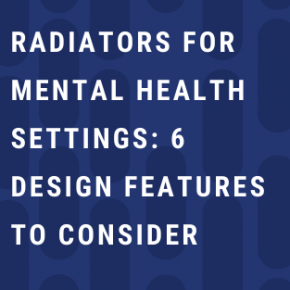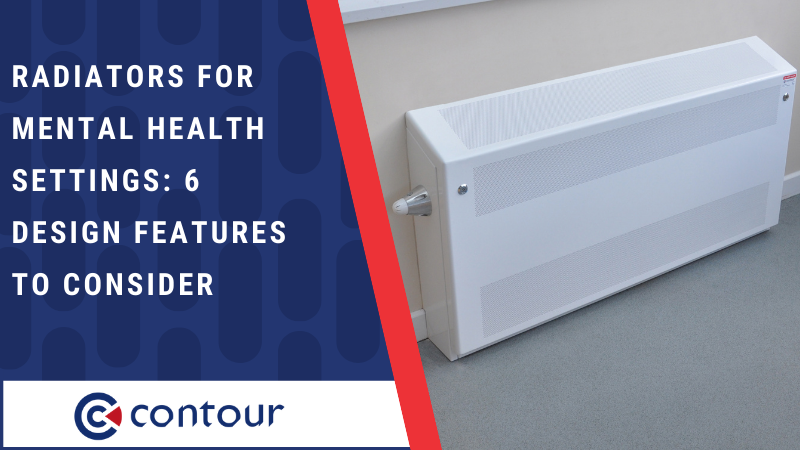
Contour: Radiators For Mental Health Settings – Six Design Features To Consider
There are three main factors to consider when selecting radiators for mental health settings, all focused on the safety of service users and staff. These are stopping dust build up, preventing ligature points and being anti-microbial. With these in mind, below are a list of design features to consider, all of which can be found in Contour’s extensive range of anti-ligature radiators.

1) Size of Radiator Grille In Mental Health Settings
The size of the radiator grille is a vital factor to consider for mental health radiators. Too large and it creates an instant ligature point, too small or non-existent and it can affect the convection process. This creates a higher-than-expected surface temperature.
While LSTs would be available, the size of the radiator grille would mean a mental health service user could easily use it as a ligature. This could cause them to inflict serious harm upon themselves.
Luckily, with Contour’s anti-ligature radiators, this problem is averted.
Meeting the IP3X industry standards (BS EN60529), featuring 2mm holes punched directly out of the guard at 4mm centres, Contour’s anti-ligature radiators meet and exceed the high standards expected of these facilities.
2) Mental Health Radiators With Rounded Corners
Sharp corners aren’t to be ignored when selecting radiators for mental health environments. Their very presence could be seen as a means to inflict damage – both to themselves and the radiator.
With sharp corners, parts of the radiator are weaker and can be easily damaged, which in turn can lead to the broken parts, the radiator itself being weaponised, or even a ligature being created. This can lead to serious harm being caused to those within the mental health environment.
With Contour’s range of mental health radiators, rounded corners prevent any of the above occurring and mean that the wellbeing of service users and staff is protected.
3) Ease Of Regular Cleaning For Mental Health Settings
Is getting into all areas of a radiator a nightmare for your cleaning staff? The solution is simple. With drop down front access, radiators can be accessed, cleaned and safely locked up again in a matter of minutes.
With access available via a pin and hex key, available only to authorised staff members, all of Contour’s anti-ligature radiators are designed to make cleaning quick and easy. This maintains the most important thing – the health, safety and wellbeing of everyone.
Not only does this unique design make cleaning far quicker, preventing unwanted dust build up, but safely locked behind key access, there is no chance that service users can access the parts of the radiator that can cause serious harm or be used as stash points.
4) Anti-Microbial Protected Radiators
When the health and wellbeing of service users and staff is the most important factor, it is important every possible measure is taken.
With the current state of the world, the prevention of infectious of diseases is at the top of everyone’s list. The radiator and heating industry are no different.
Being the only company to incorporate BioCote into LST (low surface temperature) and anti-ligature radiators, all Contour products provide an extremely effective and long-term solution to protect against harmful bacteria including MRSA and E-Coli. These are bugs which can spread rapidly throughout metal health environments.
5) Use Open Ended Shoulders To Remove Gaps
The factors above are all things your mental health radiator should protect against; dust collection points, ligatures and bacteria spread.
With the adoption of OES (Open-Ended Shoulders) the first two can be instantly solved.
An OES allows the radiator guard to neatly hide the gap between the radiator and the corner of a room. This reduces gaps from 30mm to zero.
These gaps are prime real estate for contraband. Service users could easily use them to store prohibited items or even weapons. What’s more, with the introduction of OES and reduction of these unnecessary gaps, it also stops the build-up of dust in hard to clean areas, another tick in the box of health and safety.
6) Butt Strap Detail For Added Protection
While drop-down covers enable radiators to be quickly and safely cleaned, this ingenious feature can also bring some significant, unwanted downfalls with some models having exposed butt joints.
The butt where two pieces of material join is one of the weakest parts of a radiator cover. With little persuasion, a service user could easily wedge an item in creating a ligature point. Over time, damage could be inflicted to the radiator, with sharp edges even becoming weaponised.
Step in the superhero butt strap.
With an overlapping lip, the butt strap creates a much shallower channel – 1.5mm or the thickness of the steel. This prevents anything being wedged into the join, and also the supporting strap provides the anti-ligature radiator with stronger joins.
Conclusion: Talk To Us About Anti-Ligature Radiators For Mental Health Environments
So, to summarise it all up. In order to choose the correct radiators for mental health environments, you want anti-ligature models meeting the design features discussed.
With small grilles, rounded corners, easy cleaning features, anti-microbial properties, open-ended shoulders and butt straps, Contour’s anti-ligature radiators tick all the boxes to ensure a safe mental health environment.
If you have an upcoming mental health project, why not talk to the experts at Contour today?
Contour can be contacted at;
The Mansions
43 Broadway
Shifnal
TF11 8BB
Tel: 01952 290 498
Email: sales@contourheating.co.uk
Visit Supplier's page
Latest news

28th March 2025
Ideal Heating Commercial announces 10-year warranty on Evomax 2 boiler
Evomax 2, the UK’s number one selling commercial wall-mounted boiler from Ideal Heating Commercial, is now available with a 10-year warranty.
Posted in Articles, Building Industry News, Building Products & Structures, Building Regulations & Accreditations, Building Services, Facility Management & Building Services, Heating Systems, Controls and Management, Heating, Ventilation and Air Conditioning - HVAC, Innovations & New Products, Pipes, Pipes & Fittings, Plumbing, Retrofit & Renovation, Sustainability & Energy Efficiency, Videos
28th March 2025
FLIR Si1-LD Acoustic Imaging Camera for Compressed Air Leak Detection
FLIR, a Teledyne Technologies company, introduces the Si1-LD, an industrial acoustic imaging camera that brings faster and more accurate compressed air leak detection to those operating on a modest condition monitoring budget.
Posted in Acoustics, Noise & Vibration Control, Articles, Building Industry News, Building Products & Structures, Building Services, Facility Management & Building Services, Information Technology, Innovations & New Products, Retrofit & Renovation, Sustainability & Energy Efficiency, Thermal Imaging and Monitors
28th March 2025
LIFTEX 2025 Seminar programme announced
Registration has opened for LIFTEX 2025. Now in its 37th year, LIFTEX 2025 is the UK’s only dedicated exhibition for the lift, escalator and access industry and takes place only once every three years.
Posted in Access Control & Door Entry Systems, Accessibility, Articles, Building Industry Events, Building Industry News, Building Products & Structures, Building Regulations & Accreditations, Building Services, Exhibitions and Conferences, Facility Management & Building Services, Health & Safety, Retrofit & Renovation, Security and Fire Protection, Seminars
28th March 2025
MCRMA welcomes ArcelorMittal UK to membership
A UK division of the global steelmaking business ArcelorMittal has become the latest new member of the MCRMA, the industry association representing the metal building envelope sector.
Posted in Articles, Building Associations & Institutes, Building Industry News, Building Products & Structures, Building Systems, Cladding, Facades, Posts, Restoration & Refurbishment, Retrofit & Renovation, Roofs, Steel and Structural Frames, Walls
 Sign up:
Sign up: